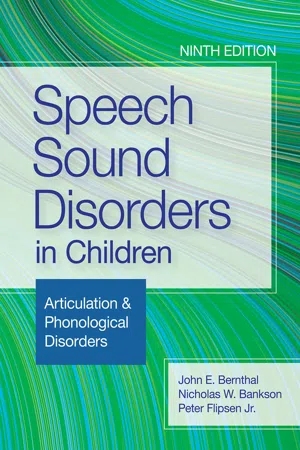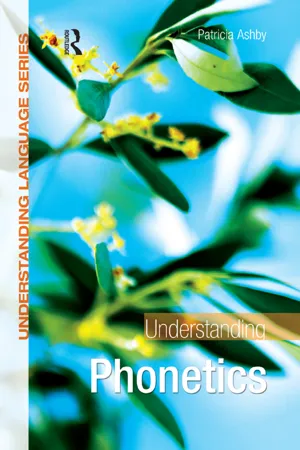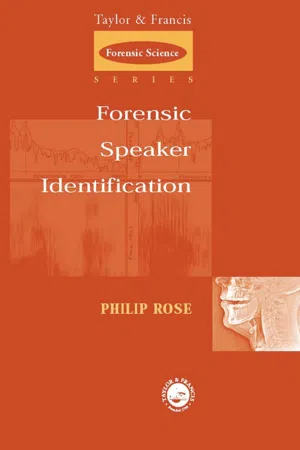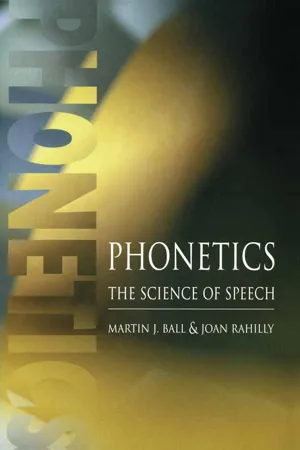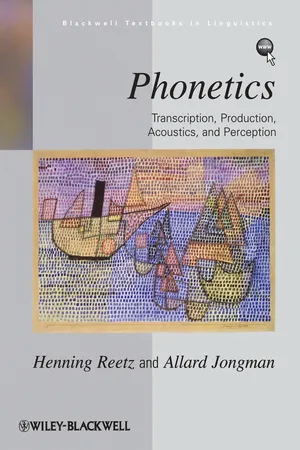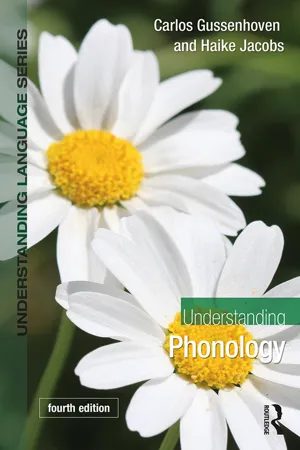Languages & Linguistics
Place of Articulation
Place of articulation refers to the location in the vocal tract where a speech sound is produced. It is a key aspect of phonetics and phonology, influencing the distinctiveness of sounds in different languages. Common places of articulation include the lips, teeth, alveolar ridge, hard palate, and velum, and the specific place of articulation of a sound can greatly impact its acoustic properties and perceptual distinctiveness.
Written by Perlego with AI-assistance
9 Key excerpts on "Place of Articulation"
- eBook - ePub
Speech Sound Disorders in Children
Articulation & Phonological Disorders
- John E Bernthal, Nicholas W Bankson, Peter Flipsen(Authors)
- 2021(Publication Date)
- Brookes Publishing(Publisher)
The manner of consonant articulation refers to the degree or type of closure, and the place of consonant articulation refers to the location of the constriction. In addition, consonants are described as voiced when the vocal folds are vibrating and voiceless when the vocal folds are not vibrating. Thus, an individual consonant can be specified by using three terms: one to describe voicing, one to describe place, and one to describe manner. Tables 2.2 and 2.3 show combinations of these terms used to specify the consonants of English. Table 2.3. Classification of consonants by place and voicing within manner Table 2.2 contains four columns, showing Place of Articulation, phonetic symbol and key word, manner of articulation, and voicing. The terms for Place of Articulation usually signify two opposing structures that accomplish a localized constriction of the vocal tract. In the definitions that follow, notice the two structures involved for the place terms: Bilabial: two lips (bi = two and labia = lip) Labial/velar: lips, and a constriction between the dorsum or back of the tongue and the velum Labiodental: lower lip and upper teeth Linguadental or interdental: tip of tongue and upper teeth (lingua = tongue) Linguaalveolar: tip of tongue and the alveolar ridge Linguapalatal: blade of tongue and palatal area behind the alveolar ridge Linguavelar: dorsum or back of tongue and roof of mouth in the velar area Glottal: the two vocal folds Each of these places of articulation is discussed more fully on the next several pages. To get a feeling for these different places of consonant articulation, concentrate on the first sounds in each word as you say the sequence pie, why, vie, thigh, tie, shy, guy, hi - eBook - ePub
- Bruce M. Rowe, Diane P. Levine(Authors)
- 2022(Publication Date)
- Routledge(Publisher)
Articulation is the production of speech sounds by the movement of the speech organs. We have noted that once out of the glottis, the airstream may or may not be obstructed in the cavity above the glottis. If it is not obstructed, we have a vowel; if it is obstructed, then we have a consonant. The following paragraphs list some of the “landmark” areas used in English to differentiate sound based on the Place of Articulation. We use the word “landmark” because various sounds can usually be produced in more than one way. The exact Place of Articulation for a specific sound will vary from person to person and even from time to time for an individual. Furthermore, sounds that we perceive as being the same often are not the same in acoustic terms. In the listing of places of articulation, English consonants are used as examples. Speakers of other languages may form sounds at articulatory locations not used in English.Articulation is the production of speech sounds by the movement of the speech organs.Bilabials are produced by bringing the lips together. This Place of Articulation can easily be illustrated by noting the position of the lips for the initial sounds in such words as pool, boot and money. These sounds are phonetically represented by [p], [b], and [m], respectively.Labiodentals, the initial sounds in five, fine, vim, and vine, are produced by raising the lower lip until it comes near the upper front teeth. The three bilabials, [p], [b], and [m], and the two labiodentals, [f] and [v], are sometimes grouped together under the general designation of labials.Dentals are articulated by the tongue and teeth, in contrast to the labiodentals, which involve the articulation of the lower lip and teeth. The two dentals in English are found in the initial sounds in think and then. When you make one of these th sounds, your tongue may go either between the top and bottom teeth or behind the top front teeth. Because both ways are the usual place for producing these sounds, the term dental would seem better than the alternative term, interdental, sometimes used to describe the th sounds. Interdental - eBook - ePub
- Patricia Ashby(Author)
- 2013(Publication Date)
- Routledge(Publisher)
uvula; the root is opposite the rear wall of the pharynx. These relationships are taken for granted when we start to delineate what we call Place of Articulation.Basically, a Place of Articulation is any passive point that is approached or contacted by its relevant active organ. The place names in Figure 3.3 correspond to the places identified along the horizontal axis on the IPA chart (see Figure 3.5 ).Only the most common articulatory places are represented in this matrix. One place not included is the infrequently used, and therefore rather rare place, epiglottal (see below). Its rarity and its often close association with the adjacent location pharyngeal enable the IPA to economize on space required for the matrix and epiglottal sounds will be found under the list of Other Symbols. Another is the equally rare linguolabial or apico-labial gesture (see below).3.2.3 A summary of active to passive relationshipsThese gestures can be tabulated and illustrated using sounds represented in the IPA alphabet as in Table 3.1 .As we can see from these summaries, the tongue is exceptionally flexible. For this reason, it rarely makes sense to talk about it as a single organ of speech. Although we do not make overt reference to the moving part when describing articulations, it is essential to get used to thinking about the tongue in terms of its various different parts. The tip and the blade, for example, can move fairly independently of the main body of the tongue. They can move forward towards the front teeth, protrude between the teeth, retract slightly, even curl over backwards. Just as Table 3.1 explains that ‘retroflex’ is a sort of shorthand for apico-palatal, so ‘dental’ is shorthand for apico-dental and velar for dorso-velar - eBook - ePub
- Phil Rose(Author)
- 2002(Publication Date)
- CRC Press(Publisher)
Since quite a lot of new sounds have been introduced above, it is useful to have an overview of some of them in a table. Table 6.1 accordingly gives the sounds for different manners mentioned above at the bilabial and alveolar place. To avoid complexity only voiced sounds are shown.Place of Articulation
It was noted above that consonants – sounds made with radical constriction of the vocal tract – are described and analysed in terms of two major parameters: the kind of constriction (manner), and the place where the constriction is made. This section describes the important places of articulation in the production of consonants. More detail can be found in Ladefoged and Maddieson (1996: 9–46).Active and passive articulators
In the phonetic description of Place of Articulation it is necessary to refer not only to where the articulation is made (this is called the passive, or stationary articulator), but also what (part of ) what speech organ it is being made with (the active articulator). Watch yourself make the fricative sounds [f ] and [v] at the beginning of the words fat and vat: your lower lip moves to position itself near or touching the upper incisors. The lower lip is the active, because moving, articulator, and the upper incisors are the passive articulator. When you make the plosive sounds [p] and [b] at the beginning of the words pat and bat, however, you can see that, although the lower lip is still the active articulator, a different passive articulator is involved: the upper lip. The same active articulator can thus make different sounds depending on what passive articulator it articulates with. This is why a full description of place needs to nominate both passive and active articulators.In fully specifying the Place of Articulation of a consonant, the term for the active articulator, which is often a latinate adjective in -o, precedes the passive term. Thus the place of [f ] and [v] is termed labio-dental. In this place descriptor, labio- means that the active articulator involves the lips, and dental - eBook - ePub
Phonetics
The Science of Speech
- Martin J Ball, Joan Rahilly(Authors)
- 2014(Publication Date)
- Routledge(Publisher)
It is usual in the phonetics literature to list these places from the front to the back (though there is no theoretical reason for this), and we will follow this practice here. The names of the places of articulation are derived from the divisions of the vocal tract (including the divisions of the roof of the mouth and of the tongue) that were introduced in Chapter 1. We show the tongue divisions in Figure 3.4, and the places of articulation labels in Figure 3.5. We also need to note that most phoneticians do not utilize the same set of place labels to describe vowels as they do with consonants (though some have attempted this). This is because the air channel with vowels is so wide, it is not always easy to associate the tongue position with any specific part of the roof of the mouth. Traditionally, therefore, different approaches have been adopted, and these are dealt with in Chapter 5. We list below, then, those terms that have normally been restricted to consonants. Articulations made with the two lips are termed bilabial. In these articulations the upper and lower lips are brought together: in the case of bilabial stops they form an air-tight seal producing the plosives [p, b] 6 or, if the velum is lowered, the nasal [m]. If a narrow channel is left between the lips, the fricatives [ɸ, ß] are produced; these are not found in English, but the voiceless bilabial fricative occurs, for example, in modern Greek, whereas the voiced one is found in Spanish. Bilabial approximants do occur in some languages, but in many they are combined in a double articulation (see Chapter 7) with some other place. In English, [w] is an approximant with bilabial and velar Place of Articulation - eBook - ePub
Phonetics
Transcription, Production, Acoustics, and Perception
- Henning Reetz, Allard Jongman(Authors)
- 2011(Publication Date)
- Wiley-Blackwell(Publisher)
4
Place and Manner of Articulation of Consonants and Vowels
In Chapter 3, we described the English consonants in terms of voicing, Place of Articulation, and manner of articulation. We also described the English vowels in terms of frontness, height, and lip rounding. This use of different dimensions in the description of consonants and vowels suggests that the articulation of these two classes of sounds has little in common. However, the articulatory description of both consonants and vowels is largely based on location of constriction (“Place of Articulation” in consonants, “frontness” in vowels) and degree of constriction (“manner of articulation” in consonants, “height” in vowels). It is therefore reasonable to use the terms place and manner of articulation in the description of both consonants and vowels.The speech sounds of English form a subset of all the speech sounds that have been documented across the languages of the world. Currently, it is estimated that there are approximately 6,000–7,000 languages in the world. However, many of these languages are spoken by only a few native speakers and are in danger of disappearing. Nevertheless, all languages are equally valuable. The fact that only a few people speak a particular language does not mean that this language is “strange” or “unnatural” – it is simply a consequence of historical (political or economic) developments. It has recently been estimated that more than half of all languages that are currently spoken will be extinct a hundred years from now. Fortunately, the languages that have been documented so far provide us with a rich inventory of speech sounds used throughout the world. The IPA chart on the last page of this book shows the inventory of IPA symbols that are available to transcribe many sounds of the world’s languages. It is clear that there are a large number of non-English sounds in other languages that we have not covered in the previous chapter on English consonants and vowels. It must be noted that the IPA was originally devised by Western European scientists and that the selection of sounds that are represented with single symbols still reflects those original languages, which also accounts for the left-to-right writing of the symbols to indicate a sequence of sounds. The current IPA is therefore a rather arbitrary mixture of symbols corresponding to letters of the Roman and Greek alphabets, modifications (e.g. inversion) of these letters, as well as borrowings from other writing and symbol systems. This choice of symbols has the disadvantage that the organizing principles of place and manner of articulation are not inherently represented. For example, it is not the case that all symbols representing fricatives share a particular graphic characteristic that distinguishes them as a class from all other symbols. Likewise, the symbols for all bilabials do not have anything in common. Nevertheless, the current set of IPA symbols can be used to represent most sounds of the world’s languages. - eBook - ePub
- Jethro Bithell(Author)
- 2018(Publication Date)
- Routledge(Publisher)
Some people can only produce the required sound by practising the exact position as taught by phonetics; good linguists, and often children (certainly children with mimetic ability) imitate the sound so minutely, though with no consciousness of their mouth position (Mundlage), that their mode of articulation automatically conforms to the sound as heard. And this, of course, is how sounds are naturally acquired in childhood: no French mother needs to tell her child to put his tongue to his teeth just where she does to her teeth; the difficulty is for the foreigner who is habituated to his own native variety of the phoneme to assume the base of articulation of the foreign variety. It is the same with the positions for the lips: Germans protrude their lips more than Englishmen, and this results in a variation of phonemes. (French requires even more lip action.) Points of articulation can in any case be only approximately stated, for the exact position assumed by the speech organs in the reproduction of a given sound depends on the sounds immediately near it. The classical example is that of k and g; these consonants before e and i are produced with a more forward position than when they are in the vicinity of a or o (pp. 43, 134). The differences in the pronunciation of the dental plosives (produced usually with the teeth pressing against the back of the upper teeth or alveoli, but sometimes against the under edge of the upper teeth) depend less on neighbouring sounds than on the locality in which they are produced; i.e. they are geographically determined (pp. 58, 134). While in North Germany (as in England) the tip of the tongue touches the alveoli, in Central or Southern Germany it touches the back of the upper incisors or even (as in France) the back of the lower incisors; the closure is then formed by the blade of the tongue—not the tip—being laid against the upper teeth or the teeth-ridge. C LASSIFICATION OF S OUNDS We have seen (p - eBook - ePub
- Ali Almanna, Juliane House(Authors)
- 2023(Publication Date)
- Routledge(Publisher)
We have seen that in the fourth stage, i.e. articulation, the vocal tract is constricted at one of the seven points. Now special attention is paid to the way in which the vocal tract is constricted, which can be classified into (1) completely blocked and (2) partially blocked, as explained in what follows.(1) Completely blocked
What are the ‘oral stops’ in your own language?Oral stops
In some sounds such as /p, b, t, d, k, g/, the flow of air through the vocal tract is completely blocked because the two articulators are brought together. These sounds, called (oral) ‘stops’ (more recently they have been called ‘plosives’), can be classified into three groups depending on the articulators used:Two articulators Sounds - the two lips are brought together; /p, b/ - the tip of the tongue pressed against the alveolar ridge; /t, d/ - the back of the tongue pressed against the velum. /k, g/ How many ‘nasal stops’ can be identified in your language?Nasal stops
In some other sounds such as /m, n, ŋ/, the flow of air through the mouth is completely blocked but the velum is lowered, thereby forcing the air to go through the nose; hence they are called ‘nasal stops’ or just ‘nasals’.(2) Partially blocked
What about the other languages or dialects that you are familiar with? Do you have these sounds?Fricatives
In sounds such as /f, v, s, z, θ, ð, ʃ, ʒ, h/, the flow of air through the vocal tract is impeded, but it is not completely blocked because the two articulators are brought near each other. Here, the air escapes through a narrow passage, thus making a hissing sound. To hear these hissing sounds, try to put your hand very close to your mouth and say these sounds one by one.Do you have these affricates in your own language or dialect?Affricates
In sounds like /dʒ, tʃ/, the flow of air through the vocal tract is completely blocked (like the stops /d, t/), but ends with a narrow opening in the vocal tract (like the fricatives /f, v, s, z/). It is worth noting that ‘affricates’ are quite common around the world, though less common than ‘fricatives’. - eBook - ePub
- Carlos Gussenhoven, Haike Jacobs(Authors)
- 2017(Publication Date)
- Routledge(Publisher)
6 Describing places of articulation6.1 Introduction
In this chapter, we introduce the features that specify the Place of Articulation of consonants and the tongue position of vowels. Among the place features, there are four univalent features specifying the major areas of articulation. These are the features [LABIAL ], [CORONAL ], [DORSAL ] and [RADICAL ]: either a segment has the feature, or it does not. This implies that, just as laryngeal segments are not specified for a number of features (those specifying either manner or Place of Articulation), not all segments will be specified for all the place features: a consonant which is not coronal will therefore not have the feature [CORONAL ]. Within these major zones of articulation, binary place features are used to characterize the more detailed articulatory distinctions. The feature [±round], for example, will be used to specify segments that are articulated with the help of the lips, i.e. that are [LABIAL ]. Segments whose articulation does not involve any activity of the lips will thus be neither [+round] nor [−round]: they have no specification for either [LABIAL ] or [±round].In this chapter we also present the notational devices Chomsky and Halle (1968) employed in their formulation of phonological rules, which often figure in phonological generalizations generally, whether these are expressed as rules or as constraints.6.2 Place Features
6.2.1 Labial
[LABIAL ] segments are articulated with the lips, like [f p m], or in the case of vowels are formed with lip rounding, like [y o œ]. Segments that are [LABIAL ] may be specified for [±round].- [±round]. [+round] segments have lip rounding, like [pw tw o u ɔ]; [−round] segments do not. In rare cases, unrounded and rounded labial segments contrast, as in Margi, Nambakaengo and Kilivila (Senft 1986). Labialized segments like [tw ] will be discussed further in chapter 14
Index pages curate the most relevant extracts from our library of academic textbooks. They’ve been created using an in-house natural language model (NLM), each adding context and meaning to key research topics.
Explore more topic indexes
Explore more topic indexes
1 of 6
Explore more topic indexes
1 of 4
